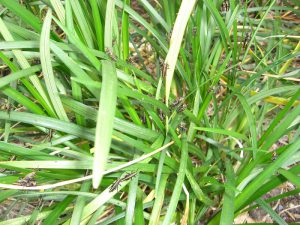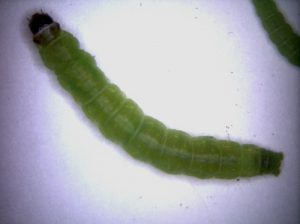
Eastern Lubber Grasshoppers are hatching early this year. You may notice them coming out of the ground in mass. At this growth stage they are black with a yellow or orange stripe down their back.
They will eat several vegetables including pea, lettuce, kale, beans and cabbage. They also like plants with long strappy leaves like amaryllis, lily, and crinum. While most critters won’t eat these grasshoppers, the loggerhead shrikes will impale them on thorns or barbed wire fence.

After a couple of days, a toxin in the grasshopper goes away, and the shrikes then eat them. Parasitic flies and some nematodes also attack these grasshoppers.
Treat the newly emerging grasshoppers before they do much damage. Physical control would include killing them by smashing, or by putting them in a bucket of soapy water. The grasshoppers tend to gather together late in the day and it is a great time to find them and knock them into the bucket.
Chemical insecticides can be used to kill them, but be aware these can also kill pollinators and other beneficial insects. Do not use insecticides on or near flowering plants, hard surfaces or near water. Insecticides that will kill the grasshoppers include carbaryl, bifenthrin, cyhalothrin, permethrin, esfenvalerate and Spinosad. Spinosad is a rather safe product, but it will take a few days to work. Always start with safer products. For the best results with any chemical spray the grasshoppers directly rather than applying it to the plant.
For more information see this link: http://edis.ifas.ufl.edu/in132

Harmless caterpillars on Oak trees. Have you noticed little white or green caterpillars hanging by silk threads from the trees? Most likely, they are the larvae (caterpillars) of either oak leafrollers or oak leaftiers, two different species of moth. This larval or caterpillar stage is one part of the moth’s life cycle.
They can cause widespread and severe defoliation (loss of leaves) to trees, but this rarely happens in Florida. They can also be a nuisance to humans, but they are harmless.
Natural controls (predators, parasites and diseases) usually keep these caterpillar populations at low levels. Mockingbirds and other birds feed on the caterpillars, and wasps also use them as a food source.
Since these caterpillars only have one generation per year they will soon be gone and you can once again walk under oak trees without the worry of them getting on you. Remember, too, that they are an important source of food for other critters in the food chain and part of the web of life. They also provide you with free fertilizer as the caterpillar droppings contain nitrogen for growing new leaves.
For more information see this link: http://entomology.ifas.ufl.edu/foltz/eny3541/Leaftier.htm

Subterranean termites are swarming. If the swarms are inside your house, you have a problem. Subterranean termites nest in the soil to obtain moisture, but they also nest in wet wood. This is important for their survival because they must have moisture to survive. They can easily attack any wood in contact with the ground. If the wood does not contact the soil, they can build mud tunnels or tubes to reach wood several feet above the ground. These tunnels can extend for 50 to 60 feet to reach wood, and often enter a structure through expansion joints in concrete slabs or where utilities enter the house.
Subterranean termites remain hidden within wood and underground, which makes them difficult to detect. A good way to determine if there is a subterranean termite infestation is to look for winged reproductives (or swarmers), shed wings, mud tubes, or wood damage. It is a good idea to keep at least a two-foot area between the house and foundation plants clear and dry. This allows a visual inspection around the house to look for these mud tubes.
For more information see this link: http://edis.ifas.ufl.edu/ig097
Ants also swarm. The easiest way to tell them apart from termites is to look at their body shape. Ants will have a very narrow waist while termites will be straight bodied and not have a waist. Termite wings are uniform in size, while winged ants have noticeably larger wings in the front than the pair in the back. Termite antenna are almost straight, while ant antenna are bent.
See this link for more information: http://flrec.ifas.ufl.edu/media/flrecifasufledu/pdfs/pestants/DifferenceBetweenAntAndTermite.pdf
 0
0
